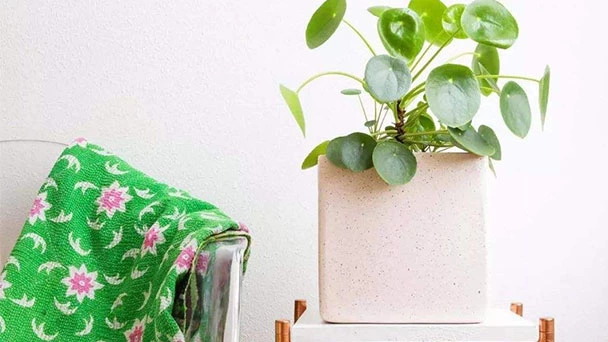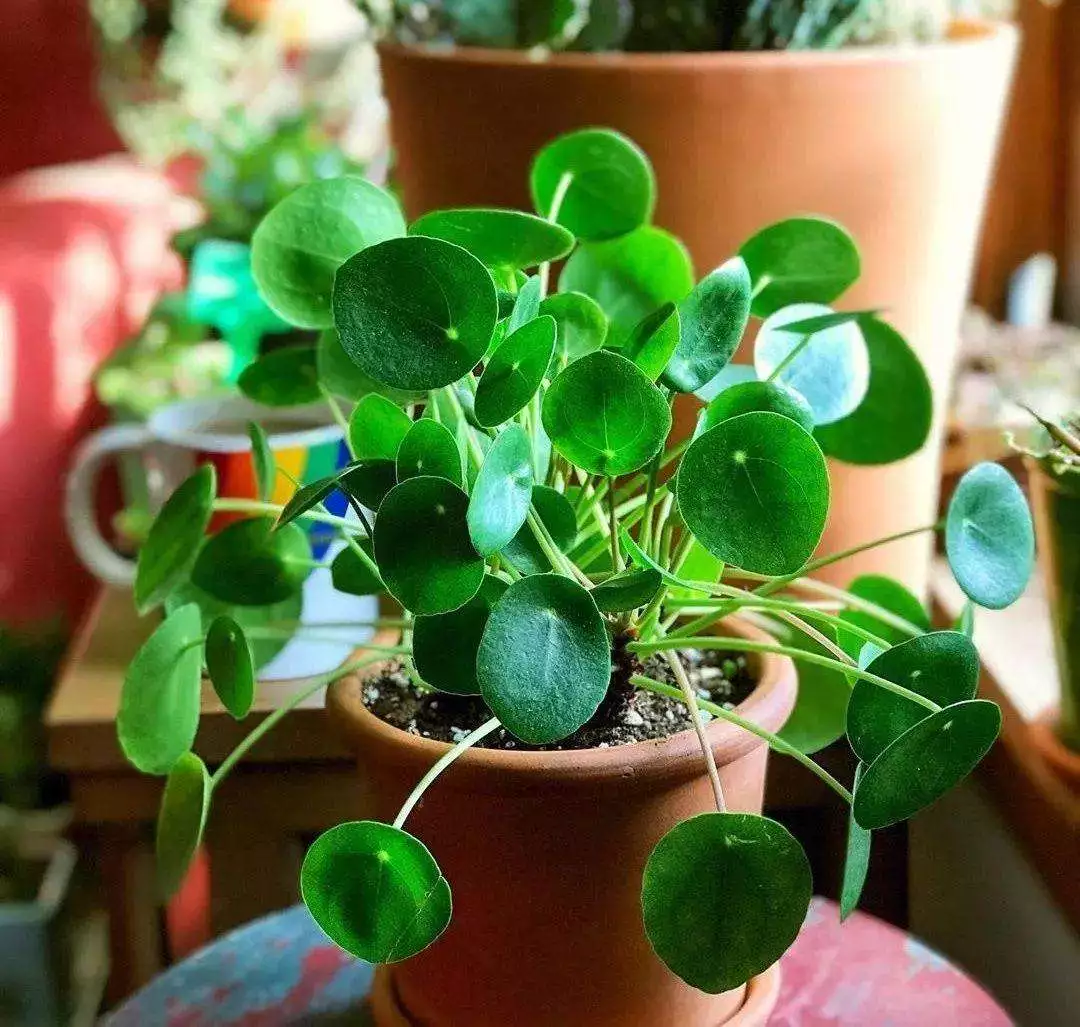How To Water My Pilea Peperomioides?
Written by Ivy
Dec 29 2021

Pilea peonomioides can grow rapidly only if it is given enough water and a humid environment. Therefore, during daily maintenance, we should not only fill more water in the water bottle, but also remember to often spray water on the leaves of Pilea peonomioides. In this way, it can promote the good growth of Pilea peperomioides leaves, accelerate photosynthesis, and avoid the occurrence of yellow leaves and rotten leaves.
However, the water content of planting Pilea peonomioides is very particular. There is such a trick. Every time you water Pilea peonomioides, add some "beer" into it. When such water is poured into the flower pot, Pilea peonomioides is like playing hormones. The more you raise it, the more vigorous it is. You can see that the leaves are big in a few days.
The specific watering frequency of Pilea peperomioides shall be determined according to the season. Every spring is the most vigorous season for its growth. It can't be short of water. It is usually watered once every two days. The weather in summer is relatively hot, and the water evaporates quickly. It should be increased to twice a day, and water should be sprayed on the leaves. The weather becomes colder in autumn, which should be reduced to once every five or six days. It will hibernate in winter. Just water it once every ten days.
The watering time for Pilea peonomioides also depends on the climate temperature. In summer, the sun is strong at noon and the temperature is the best. At this time, it is best not to water or spray water, which will damage the plant and may lead to leaf rot. it should be carried out in the morning or evening. If it is winter, the temperature at noon can be warmer. At this time, it is better to irrigate than sooner or later. The temperature difference can be smaller, which is more beneficial to the plant.
What Is The Best Soil For Pilea Peperomioides?
During the whole growth period, the basin is mainly kept wet, and it can be relatively dry in winter, but there shall be no drying phenomenon. Otherwise, the leaves of Pilea peonomioides are easy to wither and black, and water is often sprayed on the leaf surface and around in dry season.
During the growing season of Pilea peperomioides, we can water it, but be careful not to accumulate water. Water should be poured on the root, along the flower pot, not on the leaves. Low temperature in winter, the soil can be dry, which is conducive to winter. In summer, in addition to watering, water should be sprayed. The new upper basin can be poured and permeable to promote faster adaptation. If the soil you just bought is slightly wet, you don't need to water it. Just slow it down for a period of time and manage it normally.
Read More:
How Much Light Does Pilea Peperomioides Need?
However, the water content of planting Pilea peonomioides is very particular. There is such a trick. Every time you water Pilea peonomioides, add some "beer" into it. When such water is poured into the flower pot, Pilea peonomioides is like playing hormones. The more you raise it, the more vigorous it is. You can see that the leaves are big in a few days.
How Often To Water Pilea Peperomioides?When to Water Your Pilea Peperomioides?What Water Is Best for Pileas Peperomioides?How To Water Pilea Peperomioides In Different Seasons?Watering During Growing Season VS Dormancy Environmental Factors Affecting Pilea Peperomioides Watering
How Often To Water Pilea Peperomioides?
Pilea peperomioides is a very drought resistant plant, which is suitable for maintenance in a humid environment. It can grow well only when the environment is humid. It should be watered frequently during maintenance. It is not afraid of waterlogging. Even if it is soaked in water, it can grow well.The specific watering frequency of Pilea peperomioides shall be determined according to the season. Every spring is the most vigorous season for its growth. It can't be short of water. It is usually watered once every two days. The weather in summer is relatively hot, and the water evaporates quickly. It should be increased to twice a day, and water should be sprayed on the leaves. The weather becomes colder in autumn, which should be reduced to once every five or six days. It will hibernate in winter. Just water it once every ten days.
When to Water Your Pilea Peperomioides?
Pilea peperomioides should be watered in all seasons. Watering is generally carried out on sunny days. If it is cloudy and rainy, the humidity is relatively high, and there is a risk of ponding. Although the plant is resistant to humidity, it may also breed bacteria, which is not conducive to its growth. In addition, watering in summer should avoid noon to avoid the decline of ground temperature caused by water evaporation and frostbite the roots of plants.The watering time for Pilea peonomioides also depends on the climate temperature. In summer, the sun is strong at noon and the temperature is the best. At this time, it is best not to water or spray water, which will damage the plant and may lead to leaf rot. it should be carried out in the morning or evening. If it is winter, the temperature at noon can be warmer. At this time, it is better to irrigate than sooner or later. The temperature difference can be smaller, which is more beneficial to the plant.
What Water Is Best for Pileas Peperomioides?
Generally, river water or rainwater is used to water Pilea peonomioides. This soft water has a certain acidity, which is very helpful for the growth and development of plants. If tap water is used, it needs to stand for a period of time until the chlorine volatilizes, which will not affect the growth of plants. In addition, ferrous sulfate or white vinegar can be added to the water to acidify.How To Water Pilea Peperomioides In Different Seasons?

- Spring: We can water Pilea peonomioides once every 2-3 days. If it is placed in nanyangtai for maintenance, we can also supply water every day. If conditions permit, add 1-2 grains of compound fertilizer when watering, which can make the plant grow more vigorously.
- Summer: At this time, if you put it in nanyangtai for maintenance, you need to water twice a day. Because the temperature is too high, the water will evaporate faster. Aquatic plants like this kind are easy to die of drought if the water can't keep up.
- Autumn: When the weather turns cool, you need to slowly reduce the number of watering. The purpose of water supply in this season is to keep the soil warm and moist. If there is too much ponding, it will lead to root rot.
- Winter: When the temperature drops, there is basically no need to supply water. Just keep the soil slightly moist. If the leaves wither at this time, don't worry too much. When the next spring, the temperature rises, give more water, and it will be full of vitality.
What Is The Best Soil For Pilea Peperomioides?
Watering During Growing Season VS Dormancy
Generally, when the temperature is lower than 12 ℃ in winter, Pilea peperomioides is in dormancy. We should control the watering frequency, otherwise it is easy to rot the Pilea peperomioides, which is not conducive to overwintering. Always keep the basin soil moist, but avoid ponding to prevent leaf discoloration, withering and even stem rot. Watering should be dry and wet. Spray the leaves regularly to keep the air humidity.During the whole growth period, the basin is mainly kept wet, and it can be relatively dry in winter, but there shall be no drying phenomenon. Otherwise, the leaves of Pilea peonomioides are easy to wither and black, and water is often sprayed on the leaf surface and around in dry season.
During the growing season of Pilea peperomioides, we can water it, but be careful not to accumulate water. Water should be poured on the root, along the flower pot, not on the leaves. Low temperature in winter, the soil can be dry, which is conducive to winter. In summer, in addition to watering, water should be sprayed. The new upper basin can be poured and permeable to promote faster adaptation. If the soil you just bought is slightly wet, you don't need to water it. Just slow it down for a period of time and manage it normally.
Environmental Factors Affecting Pilea Peperomioides Watering
- Type of Soil
- Fertilizer
- Light
Read More:
How Much Light Does Pilea Peperomioides Need?
Latest Updated
- Benefits of Bugleweed - 7 Science-backed Health Benefits
- Bugleweed Dangers & Side Effects - Is It Poisonous?
- How to Plant Evergreen Trees - What You Should Know
- When to Plant Evergreens - Grow Guide for Evergreen Trees
- 12 Wonderful Evergreen Shrubs for Your Garden
- 12 Popular Evergreen Plants with Pictures for Beginners
- When And How To Prune A Lilac Bush Like a Pro
- How to Grow & Care for Lilac Vine (Hardenbergia Violacea)
- Japanese Lilac Tree (Syringa Reticulata) Care & Propagation Guide
- Shumard Oak Pros and Cons - What to Know
Popular Articles
- Winter maintenance of Antirrhinum Majus
- How to Grow Terminalia Mantaly Tree
- How to Grow and Care for Crossostephium Chinense
- How to grow Antirrhinum Majus in spring
- Peristeria Elata (Dove Orchid) Profile: Info & Care Guide
- Underwatered Snake Plant (Sansevieria Trifasciata) - Signs And How To Fix
- How to Care for Brazilian Jasmine Plant (Mandevilla Sanderi)
- How to Grow & Care for Graptopetalum Purple Delight in Summer
- Rosa Chinensis (China Rose): Plant Growing & Care Tips
- How to Care for Baby Sun Rose (Aptenia Cordifolia)